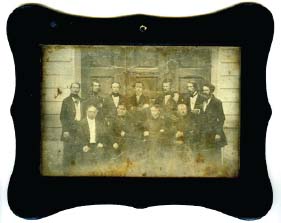
Topics in Photographic Preservation 2011, Volume 14, Article 38 (pp. 230-236)
Presented at the 2011PMG Winter Meeting in Ottawa, Canada
This paper describes a three year regional course in central, southern and eastern Europe entitled Fundamentals of the Conservation of Photographs that the Getty Conservation Institute (GCI) undertook from 2008 to 2010 with the aim of advancing the field of photograph conservation in the region. Of particular note is an approach that extends the learning experience for participants in a number of ways, beginning with a course design that utilizes both classroom teaching and distance learning activities to sustain learning over several years. The benefit of this approach to the course objectives of teaching relevant knowledge and skills, building capacity, and encouraging the growth of a strong regional network of professionals is explored.
The Getty Conservation Institute (GCI), in partnership with the Academy of Fine Art and Design (AFAD), Bratislava and the Slovak National Library (SNL), undertook a course entitled Fundamentals of the Conservation of Photographs (2008-2010) with the aim of helping to advance the field of photograph conservation in central, eastern and southern Europe. The three year course was based in Slovakia and included a group of eighteen participants from ten countries in the region. Participants included conservators, archivists, collections managers and curators at mid-career level who were responsible for the care of photograph collections. The primary objectives of the course were:

Slovak Legation to the Monarch, March 20, 1849. Daguerreotype. Photo: Slovak National Library
When the GCI conducted a needs assessment in central, southern and eastern Europe in 2006, in advance of the course, it became clear that the needs of collections and professionals in the region were enormous and pressing, and that opportunities for specialized training and education in the area of photograph conservation were very limited. The assessment also provided a tantalizing glimpse of the wealth of photograph collections, both documentary and artistic, in the region. Through conversations with institutions, cultural heritage professionals and conservators who had worked in the region, it also became clear that there were a large number of conservation professionals who were highly motivated to find ways to improve the care of their collections of photographs. The needs assessment was particularly informative thanks to a network of contacts developed by Dusan Stulik through the GCI’s ongoing “research on the conservation of photographs” project and to the willingness of the Northeast Document Conservation Center (NEDCC) to share insights from work they had done in the region.
Given the needs in the region and the challenges of acquiring skills in a subject as complex as photograph conservation, it was decided to plan the course on an extended timetable, and to look for ways to maintain contact and momentum with a group of learners, which would afford valuable opportunities to reinforce key content and create lasting relationships. In the context described by the needs assessment, stimulating the formation of a professional community was seen as crucial to advancing the field in the region in a sustainable way.
With these considerations in mind, the Fundamentals of the Conservation of Photographs course was built upon a model of annual summer schools and distance learning activities to take place over three years. A series of planning meetings followed during which experts in the field of photograph conservation generously offered suggestions for creating and refining the curriculum, and applications were solicited from the region. Apart from a professional record of caring for photographs and a passion for the subject, other criteria for selection included an interest in, and potential for dissemination and a commitment (including the formal agreement of senior management where appropriate) to the full three years of the course including both summer schools and distance mentoring activities.
The Fundamentals of the Conservation of Photographs course introduced participants to concepts and ideas related to the identification, value and conservation of photographs and photograph collections. The course comprised three successive modules, each beginning with an annual two or three week summer school at one of the partner institutions in Slovakia. The summer school was followed by an eight month “distance mentoring” phase – a period of programmed distance learning activities that participants pursued at their own institutions with the guidance of course instructors via a course web site. This model allowed (and encouraged) participants to remain engaged in the course, and with each other, over the three years of the course.
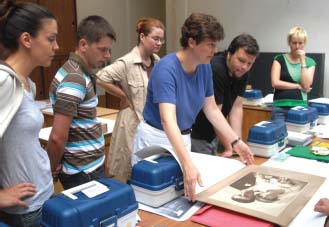
Instructor Monique Fischer discusses the condition of a photograph from a participant’s collection. Photo: Sean Charette
Summer schools focused on classroom-based instruction and group discussions and included theoretical and hands-on sessions held at the two partner institutions. Activities such as survey and process recreation made use of the unique collections and facilities at each institution. During both of the nine month distance mentoring phases of the course, participants completed a series of assignments designed to help them apply the information and knowledge from the summer school to their own collections and professional practice. At each due date, participants uploaded their assignments onto a course website. Two course instructors took on the role of “mentors’, reviewing the assignments and providing constructive feedback to participants. An equally important role of the mentors was to address questions and issues from participants and encourage others in the group to contribute to solutions and share information through an online discussion forum on the course website.
During the first module of the course, distance mentoring assignments centered on the survey of 20-30 photographs from an institution, family or teaching collection and were designed to lead participants through the process of surveying a small collection and writing a condition report and preservation plan. The work schedule was flexible with assignment due dates spread over the nine month period. Participants (and their supervisors) agreed in advance to spend an average of ten hours each month on distance mentoring activities. The assignments of the second module of the course continued to address the theme of survey (expanded in scale to larger collections and in scope to include storage and exhibition spaces, institutional policy, etc.) as well as photograph conservation terminology and vocabulary. An interesting assignment during the second distance mentoring module involved the collaborative creation of a twelve language, 150 term comparative vocabulary of photographic terms. Dissemination of information was an important theme throughout the course; participants were asked to give a presentation each summer detailing their efforts to reach their peers and colleagues and the public through dissemination activities (broadly defined).
The curriculum, distance mentoring assignments, and course activities are described in detail on the “teaching and learning resources” web page of the GCI website:
http://www.getty.edu/conservation/publications_resources/teaching/photographic_materials.html
This page hosts some of the teaching material developed over the three years of the Fundamentals course and includes course schedules, bibliographies, teaching notes, technical notes, session outlines and other resources, provided under a “creative commons license” which makes them freely accessible with minimal restrictions (for more information on the creative commons license, see: http://creativecommons.org/). An examination of these documents provides a fairly comprehensive and detailed view of the course curriculum and distance mentoring program, and also provides insight into how particular instructors taught material. The Fundamentals course, in the context of the GCI’s other project work on the preservation of photographs and photograph collections, is also described (along with the participants in the course, and other related materials) on the GCI website at:
http://www.getty.edu/conservation/our_projects/education/cons_photo/index.html
The materials noted above were supplemented with readings and presentations that were made available electronically to participants over the three years of the course via a password protected course website. The course website was based on the commercial WebEx platform. These materials are not presented on the GCI “teaching and learning resources” page due to copyright restrictions – although all of the readings used in the course (and others) are represented in the bibliography found there and are readily available (although less accessible in central, southern and eastern Europe).
Fundamentals of the Conservation of Photographs utilized a model of annual summer schools and tutored distance mentoring to deliver and reinforce content over time, in the classroom and in the workplace. This model is used in other GCI courses as well. In the case of the conservation of photographs, this extended learning model allowed key subjects (process identification, survey, etc.) to be taught in a cumulative manner – revisited from year to year in more detail or from different perspectives. Identification of photographic processes is a particularly good example of a subject that benefits from this treatment.
Distance Mentoring
The potential benefits of the distance mentoring program are clear; an opportunity to apply knowledge, with expert guidance, in one’s own work environment and with one’s own collections and colleagues. If the exercises are appropriate and the quality of the mentorship good, these experiences can serve not only to reinforce knowledge, but also to build confidence and negotiation and decision making skills. The distance mentoring part of the course also represents an opportunity for dialogue with peers and instructors which may inspire participants to consider the larger context of collections, institutions and colleagues in their region and internationally, and may widen their view of the field.
However, ensuring quality participation in a distance mentoring program can be a challenge and requires careful crafting of a program that is both appropriate and realistic for the group of learners. This entails taking into account language issues; time and workload factors; accessibility of the resources and materials (including collections) necessary to carry out the assignments; and the willingness of senior staff (or other controllers of resources or collections) to support the proposed work. It is equally important to consider the relevance of exercises to participants and their collections; and to think about how the exercises might allow (and encourage) participants to engage their colleagues and create buy-in for their work. On the other side of the equation, it is also crucial to carefully consider the mentors, and the quality of their feedback. It is important for the responses of mentors to be prompt, encouraging, and coordinated – not to promote standardization (after all, different perspectives can lead to interesting discussions in and out of the classroom), but to ensure that questions are being answered clearly and appropriately – and that opportunities to encourage participants to find answers themselves by providing relevant references, or to refer questions to others in the group – are not missed.
An assessment of the possibilities for a distance learning program should be thorough and frank, and requires research into the institutions and individuals involved. It is important to recognize that a course website may not work in all scenarios – another way of communicating (even through a series of face-to-face meetings) may be appropriate in some contexts. A program of distance learning also simply may not be appropriate in some contexts – for example if institutional commitment to provide time and access to material needed to complete the program is not forthcoming. Failure at a program of mentoring is discouraging and more detrimental than not having undertaken one at all, particularly as there are many other ways to explore extending the learning experience.
Network Building
As noted, stimulating the growth of a network of professionals in the region was another objective of the course. Structuring the course as a three year, ongoing activity provided a strong sense of momentum and many opportunities for dialogue, and had an enormous impact on the quality of relationships formed and the quantity and quality of collaborations that developed from these relationships. By the third year of the course, these collaborations ranged from joint outreach and training activities to significant joint (international) grant proposals.
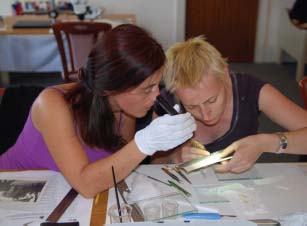
Course participants examine a photograph from the collection of the Slovak National Library. Photo: Sean Charette
Of course, the formation of relationships and networks is always unpredictable. In the case of the Fundamentals course the distance mentoring framework and the course website interface provided a platform to facilitate interaction between a diverse group of professionals. The course website served as a central repository for all of the course teaching material and as a hub for communication – both formal and informal – during the course. It was used to submit distance mentoring assignments and comments (and to share them amongst the group except in cases where confidentiality was requested). An announcement board and a group discussion forum were used to facilitate less formal communications with the whole group.
Although tempting, it is ultimately pointless to try too hard to force informal communication via a course website, especially given the ubiquity of social media resources. For the Fundamentals course, leading by example – encouraging course mentors to use the website for important announcements and to make use of the discussion forum to address questions - proved to be an effective strategy to encourage shared communication through the website. Another was to ensure that the website was functional and straightforward – a place to access important readings and information (some of it social) and to easily post and discuss relevant questions. In reality, the important consideration is not the quantity or frequency (or even quality) of informal communication as officially tracked by a course web site (it can happen just as effectively, or more effectively, in other ways). More important is the fact that it is occurring and ongoing, and is supported by both formal and informal structures and activities.
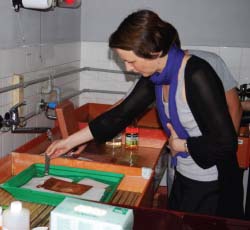
Participant creates a salted paper print. Photo: Sean Charette
As noted, in the case of the Fundamentals course participants, ongoing interaction and communication over three years had significant benefits in creating a strong group dynamic, and led to a surprising number of real collaborations. Particularly fun examples included instances where participants took the knowledge from process recreation sessions (these were a popular summer school topic, as might be expected) and created their own process recreation workshops for colleagues at their own and other institutions, and even for the public. Even more exciting were instances where participants from different institutions and countries collaborated on these kinds of activities in order to pool resources and expertise. It is gratifying to see trainees begin to fill needs for each other and for others in the field.
There were other challenges apart from those noted above. Shifting schedules and budgets meant that changes to the ideal version of the curriculum were inevitable. Some valuable lessons were learned about constructing a curriculum for such an extended period of time. Changing personal and professional circumstances meant that although the majority of participants were able to attend all three modules, several were not. A strong group meant that despite the movement of several people in and out of the course, there was not too much significant disruption. Another challenge, recognized from the beginning, was the variety of backgrounds represented in the group. As the course was focused on fundamentals, intense, supervised treatment time was outside its scope - although it was something that a number of conservators asked for repeatedly. These needs will be addressed more appropriately through future advanced level courses.
The course Fundamentals of the Conservation of Photographs was an effort by the GCI, working with partners in Slovakia and with the help of many in the photograph conservation community, to meet the needs of an emerging group of conservation professionals within a region with a wealth of photographic collections, but limited resources and very few opportunities for training. One shared priority now for the professionals who participated in the course is to find ways to promote the preservation of these collections and, more fundamentally, to work actively to build awareness of their importance.
The model of a multi-year course that includes distance mentoring activities and sustained access to teaching materials, instructors and peers worked well for this audience to extend learning and facilitate the goal of building a network of informed, well connected and active conservation professionals. The two distance mentoring phases, which followed the first and second summer schools, were a tool to take the learning process beyond the classroom and to integrate all three years of the course into an extended learning experience. Distance mentoring was a means to deepen understanding of concepts through application, and a way to encourage the formation of professional relationships through sustained communication. This dialogue was in turn able to help participants develop a wider perspective on the collections, institutions and colleagues in their region, and internationally, and to inspire broader engagement with the field of photograph conservation. This was clearly seen in the activities and collaborations that this group was engaged in by the third year of the course.
It is very encouraging to see these collaborations continue and to see the momentum in the region. Formal academic programs in photograph conservation are being discussed and established. The Academy of Fine Arts and Design (AFAD) in Bratislava, a project partner, created an MA specialization in photograph conservation in 2006, and others in the Czech Republic are following. In addition, several participants in the Fundamentals course who work in academic settings are working to establish the same at their own institutions. Outside the region, NEDCC has found funding for several years in a row to host interns from the region – and the timing for these internship opportunities could not be better.
The GCI plans to continue to contribute to the momentum in the region through future activities such as a regional symposium, and a series of workshops dealing with more advanced topics in photograph conservation. In addition, many of the course materials developed for this project (those not subject to copyright restrictions) have been made freely available for use.
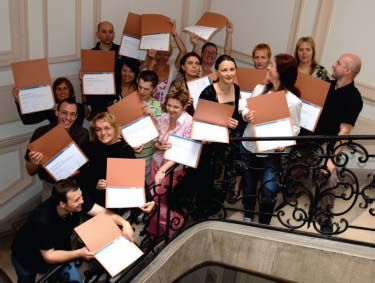
Participants at Academy of Fine Arts and Design (AFAD), Bratislava, with course certificates. Photo: Dusan Stulik
If the work of the GCI in the region can be considered successful, it is due more than anything else to hard work of the professionals who took part in the course, which represented an enormous commitment over three years, and also to the goodwill and extraordinary dynamism of the photograph conservation community, many of whom contributed generously to the course as instructors or advisors. We look forward to future work together.
Getty Conservation Institute
Papers presented in Topics in Photographic Preservation, Volume Fourteen have not undergone a formal process of peer review.